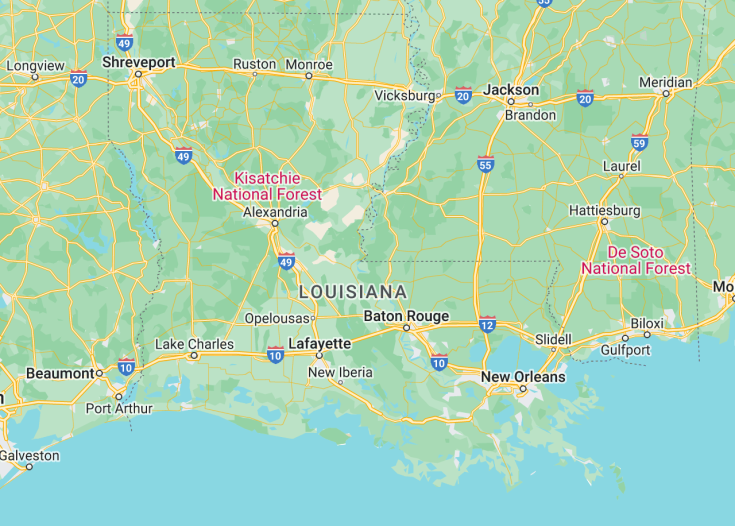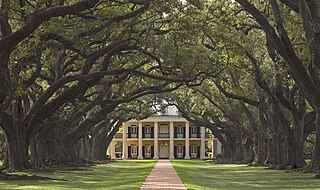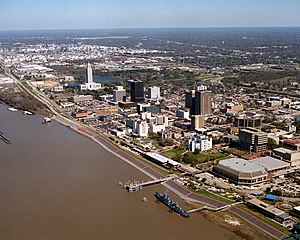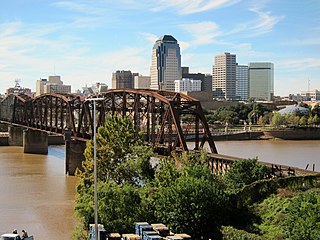Louisiana, the Pelican State, marries the rich tapestry of Southern culture, Cajun traditions, and Creole heritage. Situated along the Gulf of Mexico, it boasts a landscape adorned with bayous, sprawling plantations, and vivacious cities like New Orleans. Revel in the state’s musical lineage, from jazz to zydeco, and indulge in its gastronomic delights such as gumbo and beignets. Louisiana’s festive spirit is ever-present, most notably during Mardi Gras, where colors, music, and dance flood the streets.
Immerse yourself in the lively atmosphere of the French Quarter in New Orleans, where you can indulge in delicious cuisine, listen to live jazz music, and explore the historic streets and architecture.
Discover the beauty of Louisiana’s natural landscapes by taking a boat tour through the scenic bayous and swamps, where you can spot alligators, herons, and other wildlife in their natural habitat.
Top destinations in Louisiana (USA)
Louisiana: a unique cultural melting pot
| Capital | New Orleans |
| Time in Louisiana (USA) | CST (Central Standard Time) |
| Language spoken | English |
| Population | 4.66 million (according to U.S. Census Bureau) |
| Religion | Christianity (77.32%) Protestantism (58.63%) Roman Catholicism (17.19%) Other Christian denominations (1.5%) Other religions (4.1%) Non-religious (14.57%) |
| Currency | United States Dollar (USD) |
| Airports | Louis Armstrong New Orleans International Airport Shreveport Regional Airport Baton Rouge Metropolitan Airport |
Engulfed in a rich tapestry of history, music, and cuisine, Louisiana offers a cultural experience like no other. Located in the southern region of the United States, it stands as a testament to centuries of Spanish, French, African, and Creole influences. The result is an enchanting state bursting with vibrant festivals, distinctive music, mouthwatering food, and an indomitable spirit that has been sculpted by events like the Louisiana Purchase and the devastation of Hurricane Katrina.
The sultry allure of New Orleans, the state’s largest city, captivates visitors with its storied French Quarter, iconic Mardi Gras celebrations, and the hauntingly beautiful Garden District. Yet, beyond this famed city, Louisiana sprawls into bayous and marshlands, resonating with the rhythmic beats of Zydeco and the mysteries of voodoo legends.
A traveler’s journey in Louisiana would be incomplete without indulging in its culinary heritage. From gumbo to crawfish étouffée and beignets, the state’s cuisine tells stories of its diverse settlers. And then there’s the music: Jazz, born in the bustling clubs of New Orleans, has become synonymous with Louisiana, while Blues and Cajun sounds echo the soul and roots of this land.
Where is Louisiana located?
Louisiana is situated in the southern part of the United States, bordered by Texas to the west, Arkansas to the north, Mississippi to the east, and the Gulf of Mexico to the south.
What is Louisiana famous for?
Louisiana is renowned for its rich cultural heritage, including Cajun and Creole cuisines, Jazz music, Mardi Gras celebrations, and its unique blend of French, Spanish, and African influences.
History
Pre-16th Century: Native American Settlements
Before European exploration, the region now known as Louisiana was inhabited by a diverse range of Native American tribes such as the Caddo, Choctaw, and Atakapa. These tribes had intricate societies, rituals, and economies, with the Mississippi River and its tributaries providing a rich source of sustenance and transportation.
16th-17th Century: European Exploration
The Spanish were the first Europeans to explore the region in the 16th century, though they established no permanent settlements. In the late 17th century, the French, led by René-Robert Cavelier, Sieur de La Salle, claimed the territory and named it “La Louisiane” in honor of King Louis XIV.
1718-1762: French Colonial Era
The French formally established a presence in 1718 with the foundation of New Orleans by Jean-Baptiste Le Moyne, Sieur de Bienville. As a French colony, Louisiana became a significant trading post and gateway to the Mississippi River. It was also during this time that the African slave trade intensified in the region, forever altering its demographic and cultural landscape.
1762-1800: Spanish Control
Following the Seven Years’ War, France ceded Louisiana to Spain in the Treaty of Fontainebleau. Under Spanish rule, Louisiana experienced significant growth and change, including more liberal Spanish land grant policies and the introduction of Spanish architecture, evident in parts of New Orleans today.
1800-1803: Brief French Dominion and the Louisiana Purchase
By secret agreement in 1800, Spain returned Louisiana to France. However, the French dominion was short-lived. Concerned about French intentions in the New World, and recognizing the strategic importance of New Orleans and the Mississippi River, the United States, under President Thomas Jefferson, purchased Louisiana from France in 1803 for $15 million – an acquisition known as the Louisiana Purchase.
1812: Statehood
Louisiana was admitted as the 18th state of the Union on April 30, 1812. Its rich mix of French, Spanish, African, and Native American influences made it distinct from other American territories, a mosaic that continues to shape its culture today.
1861-1865: Civil War
During the Civil War, Louisiana seceded from the Union in 1861, joining the Confederate States of America. The state witnessed numerous significant battles, and New Orleans, due to its strategic importance, was occupied by Union forces in 1862 and remained under Union control for the rest of the war.
20th Century: Economic Growth and Social Change
The 20th century saw Louisiana transitioning from an agrarian to a more industrialized economy, bolstered by oil discoveries. The state also played pivotal roles in the Civil Rights Movement, with Baton Rouge hosting one of the first bus boycotts in 1953. Louisiana’s rich musical heritage, particularly jazz and blues, gained international recognition during this period.
2005: Hurricane Katrina
On August 29, 2005, Louisiana faced one of its most significant challenges when Hurricane Katrina struck, particularly devastating New Orleans. The hurricane and subsequent levee failures resulted in massive flooding, loss of life, and displacement. The state’s recovery from this disaster, both in infrastructure and spirit, remains a testament to the resilience of its people.
21st Century: Modern Louisiana
Today, Louisiana continues to thrive as a unique blend of cultures, traditions, and histories. Its contribution to music, cuisine, arts, and literature is unparalleled, making it a significant cultural hub in the United States. While challenges persist, the state’s vibrant spirit and rich heritage ensure its place as a cherished American destination.
Visit Louisiana
What to see and do in Louisiana
When visiting Louisiana, there are several attractions and activities that should not be missed:
- Explore the vibrant streets of New Orleans’ French Quarter, known for its historic architecture, jazz music, and delicious cuisine.
- Visit the iconic St. Louis Cathedral, the oldest continuously active Roman Catholic cathedral in the United States.
- Take a stroll along the picturesque Oak Alley Plantation, known for its beautiful oak-lined avenue and historical significance.
- Experience the unique culture and history of the Cajun and Creole people in Lafayette and Baton Rouge.
- Indulge in the flavors of Louisiana by trying traditional dishes such as gumbo, jambalaya, and crawfish.
- Explore the swamps and bayous of Louisiana by taking an airboat tour or a guided canoe trip.
Upcoming events in Louisiana
Throughout the year, Louisiana hosts a variety of events and festivals that showcase its rich culture and heritage. Some of the notable events include:
- Mardi Gras: This iconic carnival celebration takes place in February or March, with parades, music, and vibrant costumes.
- Jazz Fest: Held in New Orleans in April or May, this music festival celebrates the city’s jazz heritage with performances by renowned musicians.
- Essence Festival: Known as the “Party with a Purpose,” this event in July features live music, empowerment seminars, and community service initiatives.
- French Quarter Festival: Taking place in April, this festival showcases the best of New Orleans’ music, food, and culture in the historic French Quarter.
Best time to visit Louisiana
The best time to visit Louisiana is during the spring (March to May) and fall (September to November) when the weather is mild and pleasant. These seasons offer lower humidity levels, making it more comfortable for outdoor activities and exploring the cities. Additionally, visiting during Mardi Gras or other festivals can provide a unique cultural experience. However, it’s worth noting that hurricane season occurs from June to November, so travelers should be prepared for potential weather disruptions.
Is Louisiana worth visiting?
Louisiana is definitely worth visiting for its unique blend of history, culture, and natural beauty. The state offers a vibrant and diverse atmosphere, particularly in cities like New Orleans, where visitors can immerse themselves in the lively music scene, explore historic neighborhoods, and indulge in delicious local cuisine. Louisiana’s swamps and bayous also provide an opportunity to experience its incredible biodiversity. However, it’s important to be aware of the potential for extreme weather events like hurricanes. Overall, Louisiana offers a one-of-a-kind experience that shouldn’t be missed.
Common questions
What are the top attractions in Louisiana?
- The French Quarter in New Orleans
- The National WWII Museum
- Bayou and swamp tours
- Plantation tours
- The Cajun and Creole cuisine
What is the culture of Louisiana known for?
What is the best time to visit Louisiana?
What are some popular Cajun and Creole dishes in Louisiana?
- Gumbo: a hearty stew containing meat or seafood, vegetables, and a thick roux
- Jambalaya: a one-pot rice dish typically made with meat, vegetables, and aromatic spices
- Crawfish étouffée: a rich and flavorful dish featuring crawfish tails smothered in a spicy gravy-like sauce
- Red beans and rice: a traditional Monday meal in Louisiana, made with red beans, sausage, and served over rice
What activities can I enjoy in the Louisiana swamps and bayous?
- Swamp tours: Take a guided boat tour through the swamps and learn about the diverse ecosystem and wildlife of the region.
- Alligator spotting: Spot alligators in their natural habitat and observe their behavior from a safe distance.
- Birdwatching: Louisiana is home to a variety of bird species, making it a great destination for birdwatching enthusiasts.
- Kayaking or canoeing: Explore the waterways at your own pace and get a closer look at the unique flora and fauna.
What are some popular plantation tours in Louisiana?
- Oak Alley Plantation: Known for its beautiful oak-lined walkway and antebellum architecture.
- Laura Plantation: Offers a comprehensive tour that focuses on the lives of the enslaved individuals who lived and worked on the plantation.
- Houmas House Plantation: Known for its stunning gardens and opulent interiors.
- Nottoway Plantation: The largest surviving antebellum mansion in the South, known for its grandeur and elegance.
What are some popular music festivals in Louisiana?
- New Orleans Jazz & Heritage Festival: A world-famous festival showcasing jazz, blues, gospel, Cajun, zydeco, and more.
- French Quarter Festival: Celebrates the music, food, and culture of New Orleans’ historic French Quarter.
- Bayou Country Superfest: A country music festival held in Baton Rouge, featuring top country artists.
- Essence Festival: One of the largest African American music and culture festivals in the United States.
What are some outdoor activities in Louisiana?
- Hiking and nature trails: Explore scenic trails in state parks and natural areas, such as the Kisatchie National Forest.
- Fishing: Louisiana is known for its excellent fishing opportunities, with options for freshwater and saltwater fishing.
- Boating and kayaking: Enjoy water-based activities in lakes, rivers, and bayous throughout the state.
- Beach visits: Louisiana has beautiful coastal areas, including the beaches of Grand Isle and Holly Beach.
What is the history of Louisiana?
What are some other attractions in Louisiana besides New Orleans?
- Baton Rouge: The state capital with historical landmarks, museums, and the renowned LSU campus.
- Avery Island: The birthplace of Tabasco sauce and home to the beautiful Jungle Gardens.
- Lafayette: Known as the heart of Cajun Country, offering unique cultural experiences and delicious cuisine.
- Shreveport: A city in northwest Louisiana known for its riverfront attractions, casinos, and annual events.
What are some famous Mardi Gras traditions in Louisiana?
- Mardi Gras Parades: Colorful and elaborate parades featuring themed floats, marching bands, and costumed participants.
- King Cake: A traditional pastry usually decorated with vibrant colors and filled with sweet fillings like cream cheese or fruit.
- Mardi Gras Balls: Formal events where attendees wear elaborate costumes and masks and enjoy music, dancing, and traditional rituals.
- Throws: During the parades, participants on the floats toss various items, known as “throws,” to the spectators, including beads, doubloons, and small toys.
What wildlife can be found in Louisiana swamps?
- Alligators: Louisiana is known for its alligator population, and the swamps offer opportunities to observe these fascinating reptiles up close.
- Birds: Louisiana is a haven for birdwatching, with a variety of species including herons, egrets, pelicans, and warblers.
- Turtles: Several species of turtles, including snapping turtles and softshell turtles, can be found in the swamps and waterways.
- Fish: The swamps and bayous of Louisiana are teeming with fish species such as bass, catfish, and bream.














